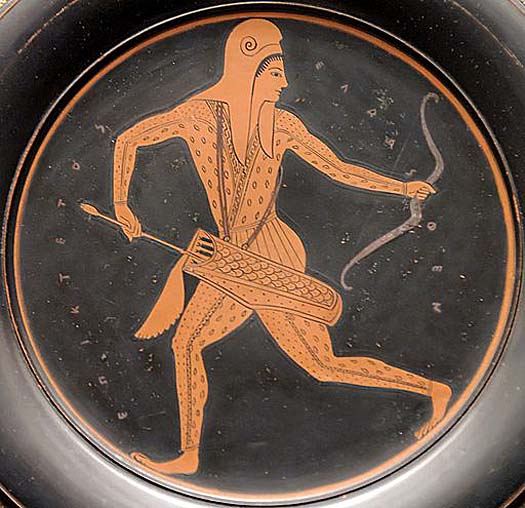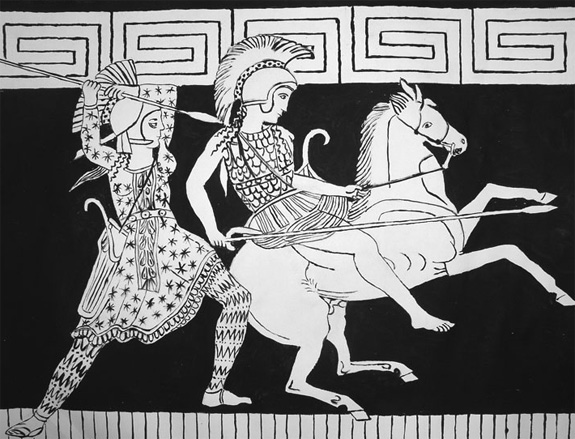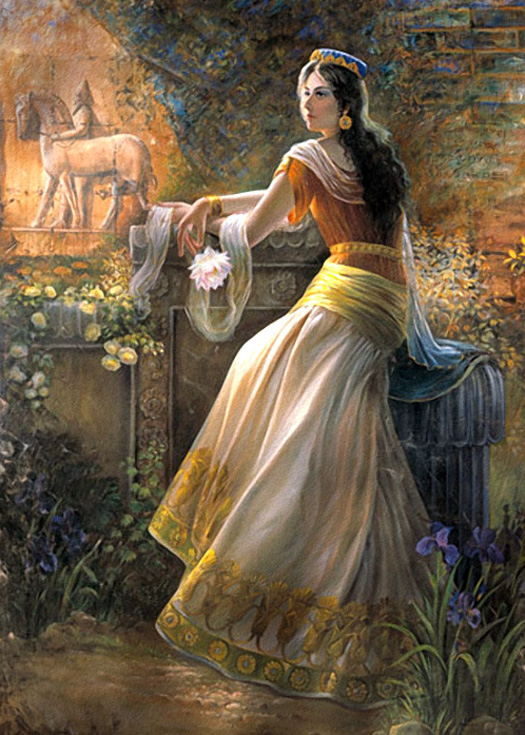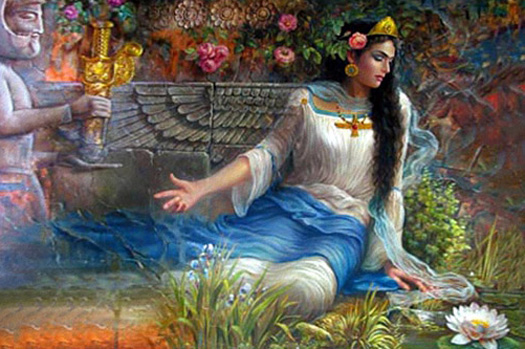
| PERSIA WOMEN WARRIORS
Persian Warrior Woman Archer – Replica Plate of the original Greek Art Women in Persia, had equal amount of rights as men and were treated with great respect. They enjoyed social and legal freedom, and were active members of the society. For example, they had employment opportunities and earned wages. Also, they were able to engage in religion, and even had the chance to become a priest. In addition, they shared their responsibilities and decisions with men while still being able to have control over their own wealth and economic independence. Surprisingly, women were also allowed to manage and own their own property. Lastly, the Persian women were great fighters. Some women even joined the Sassanid army where they would fight with swords mostly on horseback. In conclusion, women in Persia had the same amount of rights and privileges as men.
Women in Ancient Persian Empire were valuable beings; they often had important positions in the Courthouse, Cabinet Ministries, Military, State Department, Financial Institutions and other official administrations. Later on, during the First Arab Invasion-Occupation (651 AD), some of the Persian Women gathered Commando and Guerrilla armies, and some associated with their fellow men, combining the resistance forces against the foreign oppressors.
Those brave Persian Women with cooperation of their brave male partners, had managed to free Iran from the "First Arab Invasion-Occupation" (651 AD). The sacrifices of Iranian men and women, under the leadership of Yaqub Leis Saffarid, the son of a simple coppersmith, had freed Iran on 873 AD and ended the 222 years of Arab occupation (651 AD - 873 AD) of Iran.
Women of Iran, once upon a time, you were Ruling Monarchs, Queens, Prime Ministers, Secretaries of State, Military Generals, Navy Admirals, and Empresses of the land.
Kaveh Farrokh’s explains in her lecture the role of women on the Iranian plateau from the Bronze Age both before and after the Indo-European arrivals. The prime importance of women in Iranian speaking tribes in the Caucasus, Eastern Europe and Central Asia (i.e. Scythians, Sarmatians, etc.) and the Iranian plateau are detailed, notably the Achaemenid and the ensuing Partho-Sassanian eras.
Persian Immortal Warrior Woman with her spear (left) attacks the Greek Cavalry (right) on horseback - Replica art from the original Greek Vase Persian female names and meaning :
Mitra
(Mithra) = Sun Goddess (Goddess of the Major Ancient Persian Religion
of Mitraism)
List of names of Persian women warriors :
Ahreeman X Dynasty :
1.
Pantea (strong and immortal) [6 BC]
Note 1 : Special Infiltration Units (Special Forces) of the Immortals wore their swords on their back during the special operations; this would allow their hands and bodies to be free for maneuvering, crawling, climbing, hand to hand combat and surprise attacks.
Note 2 : Desert Combat Units wore scarves or masks on their faces to protect their noses and mouths from the desert sands during the sand storms.
Artemisia the Persian Grand Admiral Woman Warrior of Xerxes the Great. Artemisia often fought with two swords.
She was great Warrior Woman, Arteshbod General (Field Marshal) and wife of Darius II Shahanshah of Iran
11.
Artadokht (Truthful girl) [1 AD]
Artadokht 12.
Sura (Flower Face) [3 AD]
Sassanid Dynasty :
13.
Azadokht (Free Girl) [3 AD]
Apranik, was a Sassanid High Ranking Commander of Army. Like her father, she decided to become a professional soldier. Piran was a famous Persian General, and when Arabs invaded our land Piran was like a solid rock standing on their way. Apranik since childhood, she loved military. She was Father's Right hand, and the amazing Nationalistic Feelings that she developed during her teenage years, forced her to become a military person. Apranik, joined the mighty Persian Army. Due to her worthiness, and not her father's influence, she climbed the steps of progress, one by one and after her complete education, she managed to rise from a petty officer, to a full commander of the Persian Army.
When Arabs invaded Iran, Apranik took the command of a major battalion of his father's Army. For years to come, Apranik, first fought an official war with the Arabs, and later on when all hopes were destroyed, Apranik, started her Hit and Run Rebellious Campaign against the Arabs. Apranik's Commando Warfare was legendary. Apranik’s campaigns put the fear of Persian Rebels.
Apranik Arab Occupation Era :
19.
Negan (good destiny) [7 AD]
Negan was not a military woman, nor a woman of nobility, yet she had a heart full of love of Iran. She had decided to pick up the sword and lead a band of resistance fighters against the Arabs who invaded Persia.
Azad
was a Persian Warrior Woman Daylamite Guerrilla Commander of Gilan.
The central area of activity for Azad was State of Daylam (today's Gilan). Azad a Daylami (Gilani) Guerrilla Commander, a partisan leader from Caspian Sea shores in north Iran, who fought for various years with her freedom fighters against the Arabs. Azad was from Daylam (Today's State of Gilan). Daylam had a history of rebellion. Until this day, State of Gilan has been the mother and the home for many of the Revolutionaries and freedom fighters of Iran. Azad-e Daylami (Azad of Daylam) was one of the very first brave daughters of this region. She became one of the most famous freedom fighters of the region and a symbol of Persian Resistance.
The
famous female commando and revolutionary Banu, was a lioness. The
central area of activity for Banu was State of Atropatgan or Azar-Abadegan
(Today's Azerbaijan). Wife of Babak Khoramdin (Persian Legendary
Freedom Fighter), she fought side by side to her husband Babak,
during the occupation of Iran by Arabs. She fought to the end. She
was the better half of Babak Khoramdin. Banu was a temperamental
Azeri Woman, with determination of steel from Azerbaijan or as it
used to be called State of "Atropatgan". This amazing
woman was a skilled archer; she grew up with her bow and arrows!
She was Babak's partner in life and death, in war and peace.
Buran's time was later on during the occupation years. When Arabsruled every aspect of life in Persia, and when fighting by the sword and arch was not possible, Buran the wise daughter of Hassan Sahl launched a different type of a battle! She grew up to become a politician. Furthermore, she became the first female Wazir (Prime Minister); morely, the first Non Arab Wazir of the complete Islamic Empire! Just imagine the sound of that! A female Persian Wazir in the Arab court of Ma'mun, The Caliph of Abbasid! A Persian woman with that kind of power, could do many goods for Iran, and indeed she did. She actually fought the Arab Hierarchy from within. She was in the inside, way inside; therefore, she started her famous "Changes from the Within" reforms. Buran, Daughter of Sahl, fought the political war and forced many reforms for the benefit of the Persians' Lives to the Abbasid's Government. During her years in office, she fought for the rights of Minorities (Non Arabs) in the Islamic Empire.
Buran
made life much easier for Persians and other Non-Arabs under the
reign of the Islamic Empire.
Source
:
https://iranpoliticsclub.net/ |



